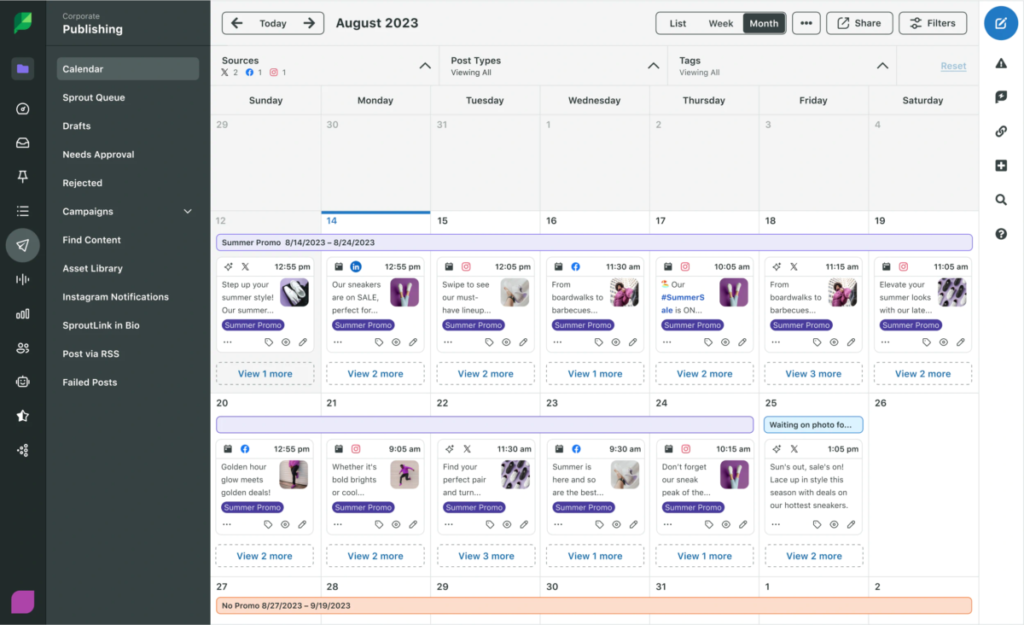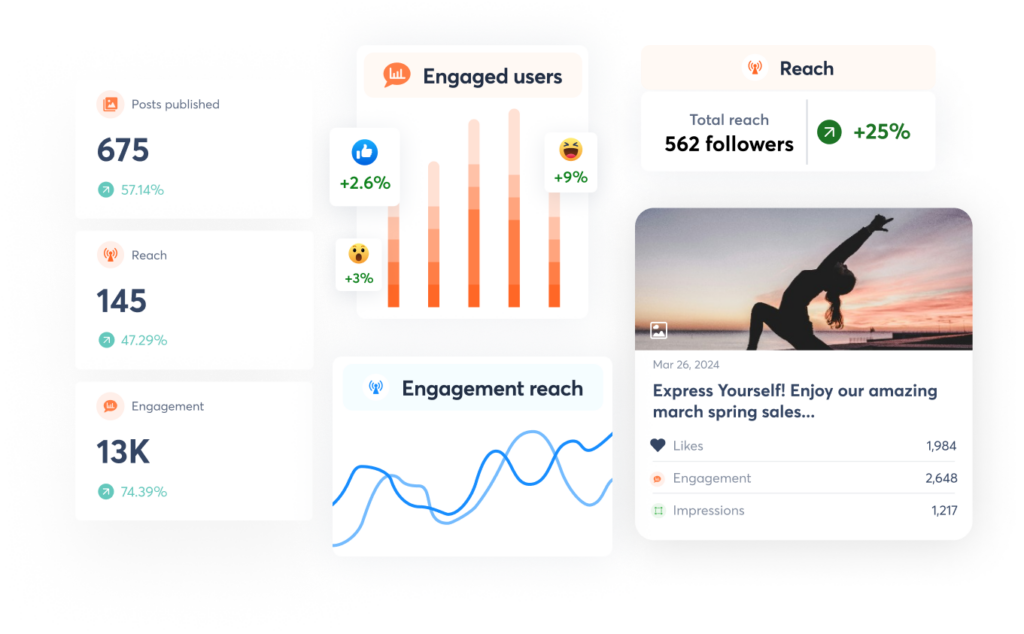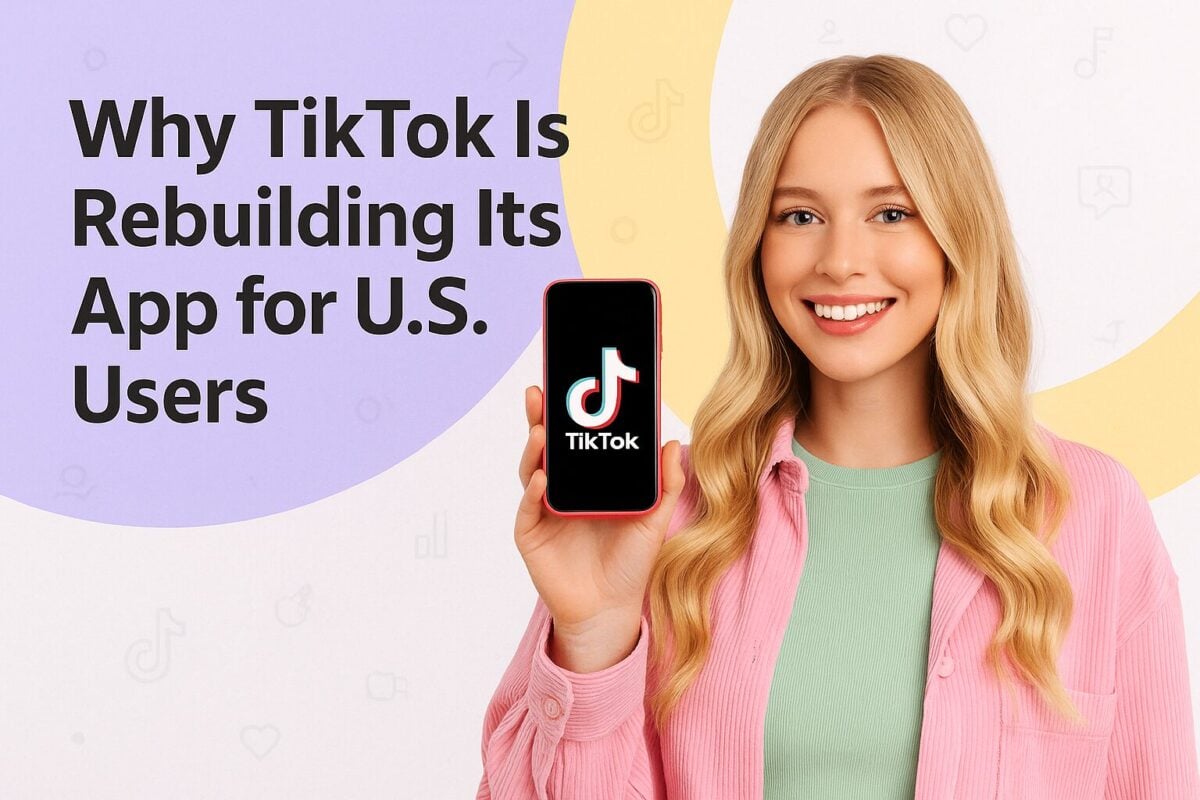An effective social media content strategy goes a long way toward building a successful online presence that will drive your followers to convert. It helps you organize your content creation and publishing efforts for a greater impact. Here, we'll walk you through the seven steps you can use to create an effective social media marketing strategy you can be proud of.
What Is a Social Media Content Strategy and Why Do You Need It?
A social media content strategy is a framework that outlines how you create, publish, and manage your content for social media. It covers everything from what you post, when you post, and how often you post, to analyzing and tweaking your content to improve performance.
The point of creating and using a strategy is so you can organize your content creation and publishing efforts to achieve specific goals. It helps you ensure that you’re creating the exact content needed according to those goals – whether it involves driving traffic or growing your social media presence. As such, it ensures that your social media marketing efforts are focused and organized, enabling you to yield a higher return on your investment.
How to Create a Small Business Social Media Content Strategy
Content is the backbone of any social media marketing strategy. And it’s crucial to have a strategy in place so you can ensure that you’re publishing high-quality and engaging content. Here's how to build an effective social media content strategy for your small business in seven steps.
Step 1: Set Goals for Your Content Strategy
Setting goals is vital to success in just about everything and social media is no exception. What do you want to achieve through your social media content? This will determine the types of content you create for your social media channels.
You can build a diversified content mix to achieve various goals, but we recommend starting out with just a few goals (3–5, tops) that are the most important to you. This will allow you to focus your content strategy so that your ideas aren’t all over the place.
Let’s give you an idea of the various types of content you can create based on the unique goals you have:
- Increasing brand awareness – User-generated content, influencer-generated content, paid ads
- Managing your brand reputation – Content highlighting corporate social responsibility efforts, repurposed reviews and testimonials
- Driving traffic to your website – Blog post previews, informative content, and product photos with links
- Generating new leads – Demo videos, lead magnet offers
- Understanding your customers better – Surveys, polls, questions
- Boosting sales – Shoppable posts, promo offers, social proof content
These aren't the only goals you can set regarding your social media presence. Each brand is unique and will have different things they're hoping to achieve. Similarly, there are a wide range of content options that you can leverage to achieve these goals.
For instance, Tentree published the following Reel that provides an engaging showcase of their bags. The video highlights some key features and functions of the bags and includes a caption saying that their bags are “as ready for your next adventure as you are.” This is the type of content that you might publish to accomplish the goal of driving sales.
Step 2: Define Your Target Audience
The next step in creating a strong social media content strategy is to define your target audience. This doesn't mean making a bunch of assumptions about who you think is your target audience. Instead, leverage the wealth of data available to you to learn more about who your target audience really is.
We find it incredibly helpful to create buyer personas for each segment of your target audience. This will help you better understand each segment so you can create the kind of content they'll want to engage with and that will drive them to take action.
You'll want to consider demographic, geographic, psychographic, and behavioral data like age, location, job title, industry, interests, fears, motivations, pain points, and more. This information is easy to get access to with most social media analytics tools that provide audience insights. Even without a tool that will consolidate this information across social media platforms, most social media platforms have their own audience insights tools.
We recommend using a platform like Audiense Insights to get some of the most comprehensive understanding of your social media target audience. This comes with audience identification and segmentation features that allow you to define your target audience based on interconnectivity and affinities as well as passions and interests. So it goes beyond surface-level information and digs deeper into the things that truly matter, allowing you to create content that resonates.

Source: audiense.com
Step 3: Analyze Your Competitors
After you've learned about your target audience, you're ready to learn more about your competitors. A social media competitive analysis is an essential step to building your content strategy as it provides you with insights on the types of content that resonate with your audience. It also gives you a better understanding of the types of content you should avoid.
Look into the various content your competitors are posting across their socials. Which formats are they using the most? Which ones are they not using enough of? How are they adapting their content to different platforms?
Check out how they’re tackling different topics relevant to your industry and how their audience is responding. Find out their top-performing posts and look for patterns that make them different from low-performing ones. You can then use these insights to inform your own approach to social media content.
For example, if you notice that your competitors are getting tons of engagement with Reels, you might want to focus most of your resources on creating short-form video. Alternatively, you might notice that their how-to content pieces are performing much better than their product promo posts. This might give you an idea that the audience is more responsive to content that offers value by teaching them something.
Make use of competitor analysis tools such as BuzzSumo to easily monitor your competitors’ content strategy. The tool allows you to track engagement received for various content types so you can quickly identify what works for your competitors.

Source: buzzsumo.com
Step 4: Define Your Platforms and Topics
When you're building a social media content strategy, you can't just share to all the social media platforms out there. First, there are too many of them. And second, your target audience isn't going to be on all of them. So it’s important to focus your efforts on the most relevant and impactful platforms to get the most out of your social media marketing efforts.
From there, it's just a matter of deciding what you're going to talk about. You'll want to promote your products and services, of course, but it's important to always entertain with your content or add value to your content instead of just selling all the time. To do that, you'll need to put thought into what your audience wants to know, what will help them and can still be related to your products, services, and brand.
For instance, if you're creating social media content for a landscaping service, you might share information about different plants and flowers. Or you could create content that provides instructions such as how to create an outdoor entertainment space. You might even branch off into less directly related content like "hosting the perfect outdoor dinner party.”
It's important to keep things diversified so you’re not boring your audience with the same old stuff. This will also help you appeal to a larger audience as you publish different types of content that would address varying audience needs. Check out our extensive list of social media post ideas to find inspiration on what you could post about.
For Chewy, their social media content strategy includes a mix of entertaining videos and user-generated content. They also regularly share information that would be helpful for pet parents such as how to increase walk time.
Step 5: Create a Social Media Content Calendar
Once you've determined the platforms you're going to use and the types of content you want to share, it's time to create a social media content calendar. This will help you organize your content publishing efforts so you can ensure that you're posting often enough, on the right days, and at the right time to reach your target audience.
As you build your content calendar, you'll start to notice gaps in your content and posting schedule or places where your content is too heavy on promotions. In other words, your social media content calendar is going to help you make sure that your content is engaging and interesting and peppered with just the right amount of salesy content.
Many social media management platforms come with visual content calendars that you can use to easily plan and adjust your posting strategy. When you can visualize the posts you’re planning to publish for the rest of the week or month, it’s easy to notice imbalances and effortlessly make adjustments to balance things out.

Source: sproutsocial.com
We recommend following the "rule of thirds" when planning your social media content calendar. This means that one-third of your posts are going to promote your business, one-third is going to be more personal or candid stories to build your brand's personality, and the final one-third is going to be posts filled with ideas and tips from influencers and thought leaders in your industry.
Having a content calendar in place will also simplify your content scheduling. You can plan your content to automatically go out on specific dates and times to ensure that you’re posting consistently and at the right times. This will help you boost your visibility and engagements as you schedule your posts at times when your audience is most likely to engage with them.
You can use your native analytics dashboard to discover your audience’s most active times. Or if you’re using a social media management platform, you could get automated suggestions on optimal post times based on an analysis of your content engagement patterns.
On a similar note, a content calendar is the best way to ensure that you’re posting frequently enough but not too often that you’re overwhelming your audience. You can easily visualize when you have your posts scheduled, so you can see which days and times have too many scheduled posts and which ones don’t have enough. This will allow you to adjust your scheduling to better balance things out and optimize your posting frequency.
Step 6: Create and Curate Content
Now comes the really fun part: creating and curating content! Using your calendar and the "rule of thirds," you can start to put together content that will engage and inspire your target audience. If you're not sure what to create, don't worry. Here are some great ideas for content to include in your social media content strategy.
-
Influencer Content
Have influencers create content for your brand and repost them on your socials. This is a great way to maximize your reach by directly getting your brand in front of an influencer’s audience. Meanwhile, it also helps you keep things fresh by posting influencer-generated content.
Partner with an influencer whose audience overlaps with yours. There are several different types of influencers, each with its advantages and disadvantages, so be sure to choose an influencer that makes sense for your brand's goals. For smaller businesses and narrow niches, this might mean looking at nano and micro-influencers since they tend to have higher engagement rates.
For brands like Chewy, partnering with mega influencers like chef Bobby Flay was the perfect way to get the word out about their Made by Nacho sale. The brand reposted the influencer’s video on Facebook to further amplify reach.
-
Stories
Instagram Stories and Facebook Stories are a great way to reach your followers and tap into the psychological principle of FOMO ("fear of missing out") since they'll want to watch your content before it disappears. Of course, that also means you have to create content that they won't want to miss. Use Stories to share behind-the-scenes footage, ask questions, conduct polls, announce sales and promotions, share company news, and more.
-
Audiograms
If you're a YouTuber or podcaster, you can share interesting snippets of your content on your social media platforms using audiograms. This creates a visually appealing version of your audio content. There are several apps you can use to create attractive and engaging audiograms like the aptly-named Audiogram, as well as Headliner, Wavve, and others.
-
TikToks & Reels
TikToks and Reels use short-form video content to entertain, educate, and engage your followers. They come with built-in video production and editing features that help you come up with highly entertaining content. You can add voiceovers, captions, filters, effects, and even trending sounds to create engaging short-form videos.
These types of content are great for sharing bite-sized information and instructions. Check out how Bubble Skincare nails it with the following TikTok showing a 2-step instant refresh routine.
@bubblecaption: Hit refresh ? with Bounce Back and Slam Dunk for soft, dewy skin on repeat. TYSM @ericaaadominguez for featuring the routine!♬ original sound - ????????
-
Product Shots
Your promotional content has a lot to compete with on social media, so it needs to be visually-appealing and matter to your followers. Images of your products have to be just as artistic, entertaining, and fun as the rest of the content you share. Really consider your brand's personality and branding to create product shots that work. Consider adding fun backdrops and animations to make your products pop.
-
Candid Content
Candid content is a great way to humanize your brand and build a connection with your target audience. Share personal content that shows you and your team being real and human. And don't forget to have fun.
-
User-Generated Content
User-generated content (UGC) is content created by consumers that you can then use as social proof to promote your brand. When you consider the value consumers place on trust in making their purchasing decisions, UGC is probably one of the more important types of content you can use.
UGC gives prospects the confidence to choose your brand after seeing other consumers vouching for it. It also helps them put your products in context so they can better understand the value or purpose they serve.
Denny’s Diner regularly reposts user-generated content to show others just how much people love their food. These posts range from people eating in their diners to people creating hilarious memes about how much they love the diner.
-
Repurposed Content
After you've created and used content, it doesn't have to be dead to you. You can repurpose content to get more use from it. For example, some YouTube influencers are starting to share their content on IGTV to generate more interest and more views. You can also repurpose your TikTok content for Instagram Reels and vice versa. Just remember that social media platforms love native content so you'll want to remove watermarks from your TikTok videos before repurposing them for Instagram Reels.
-
Stock Photos
While creating your own content is never a bad idea, don't shy away from using stock photos when they work. They're a great way to create beautiful visuals without tons of effort or money. Whenever you want to highlight what you're saying (typing), a stock photo might be the perfect companion.
-
Behind-the-Scenes
We've briefly mentioned behind-the-scenes content, but it deserves its own little section. Consumers want to know what kind of people they're supporting. With behind-the-scenes content, you can let consumers get to know your team and give them an exclusive look at how you do some of the things you do.
For instance, Rifle Paper Co. shared the following Reel to showcase the process of creating limited-edition posters using screen printing. Comments poured in talking about how much work goes into the process and how special it is to see it.
-
Games & Challenges
People want to be entertained on social media. While participating in games and challenges is a great first step for brands to take (if it makes sense with your branding, of course), it's even better for brands to create their own games and challenges. This type of content can go a long way toward getting you more user-generated content, expanding your reach, and increasing engagement.
Chipotle keeps things fun and entertaining with the following game that shows people a Chipotle item that corresponds with their initials. It features a slideshow of various items such as pinto bean and napkin corresponding with an initial.
-
Memes
Stepping up your meme game is one of the most effective ways to entertain and engage your audience because who doesn’t love memes? Share relatable and entertaining memes that are on trend and relevant to your business to diversify your feed. This is also the perfect way to build a connection with your audience and build a strong brand community. BarkBox is great at this, creating memes that are highly relatable for dedicated pet parents.
Step 7: Assess and Adjust Your Social Media Content Strategy
The last step in building a social media content strategy that actually works is all about tracking your results and using those results to fine-tune your strategy. See which types of content resonate with your audience based on how they’re engaging with it. This will help you adjust your content creation efforts to better align with what your audience wants to see from you.
Similarly, you’ll also want to optimize post timings and publishing frequencies to understand what works for you. Should you post less often or ramp up your publishing efforts? Should you move your posting schedule around a bit to test different times of day? These are important questions you can answer when you assess your social media content strategy.
Go beyond the data provided natively in your social media account. You can make use of third-party social media analytics tools to extract more in-depth insights into your performance.

Source: agorapulse.com
There are several social media metrics that will help you understand how your content is performing:
- Reach: The number of unique views your content received. This tells you how far your content makes it into the user's feeds.
- Engagement: The number of interactions with your content divided by impressions (number of views). This lets you know how willing your audience is to act on your content.
- Clicks: A simple count of the number of clicks your content gets. This helps you understand what causes your followers to click.
- Likes (organic and paid)
- Sentiment: A measure of how users react to your content, how they feel about it.
While you can track vanity metrics, we recommend focusing on social media benchmarks that are actually going to help you understand what makes your followers take action instead of passively consuming (or ignoring) your content.
After you know how you're performing, start making changes to your content. The goal is to improve your performance so you'll want to go back to your metrics, again and again, to make comparisons and ensure that your changes are having a positive impact.
Social Media Content Strategy Template
A social media content strategy template is essential for organizing and executing your social media marketing efforts effectively. It includes sections for defining your target audience, setting SMART goals, choosing the right platforms, and planning content types and posting schedules. Additionally, it outlines how to measure success through specific metrics, allowing for adjustments based on performance data. This structured approach helps ensure that your social media activities align with your overall business objectives and resonate with your audience.
For a comprehensive template, you can download one below:
Social Media Strategy Template
Let Your Content Strategy Fuel Your Social Media Content Strategy
When you have a solid social media content strategy, you’ll know exactly what to post and when to achieve your marketing goals. That way, you can achieve long-term success and get more out of your social media investment. Make the most of the steps we shared above to build a powerful content strategy for your social media efforts.
Frequently Asked Questions
What are the 7 steps of content strategy in social media marketing?
The seven steps of content strategy in social media marketing are:
- Set Goals for Your Content Strategy
- Define Your Target Audience
- Analyze Your Competitors
- Define Your Platforms and Topics
- Create a Social Media Content Calendar
- Create and Curate Content
- Assess and Adjust Your Social Media Content Strategy
What are the 4 C’s of social media content?
Content, conversation, community, and connections are the four C’s of social media content.
What are the 3 E’s of social media content?
Engage, educate, and entertain are the three E’s of social media content.
What content is best for social media?
Short-form video, Stories, memes, polls and questions, user-generated content, influencer-generated content, contests and giveaways, and games are some of the best types of content for social media.
What are some types of content in social media?
Text-based posts, Stories, Reels, images, carousels, user-generated content, and livestreams are some types of social media content.



